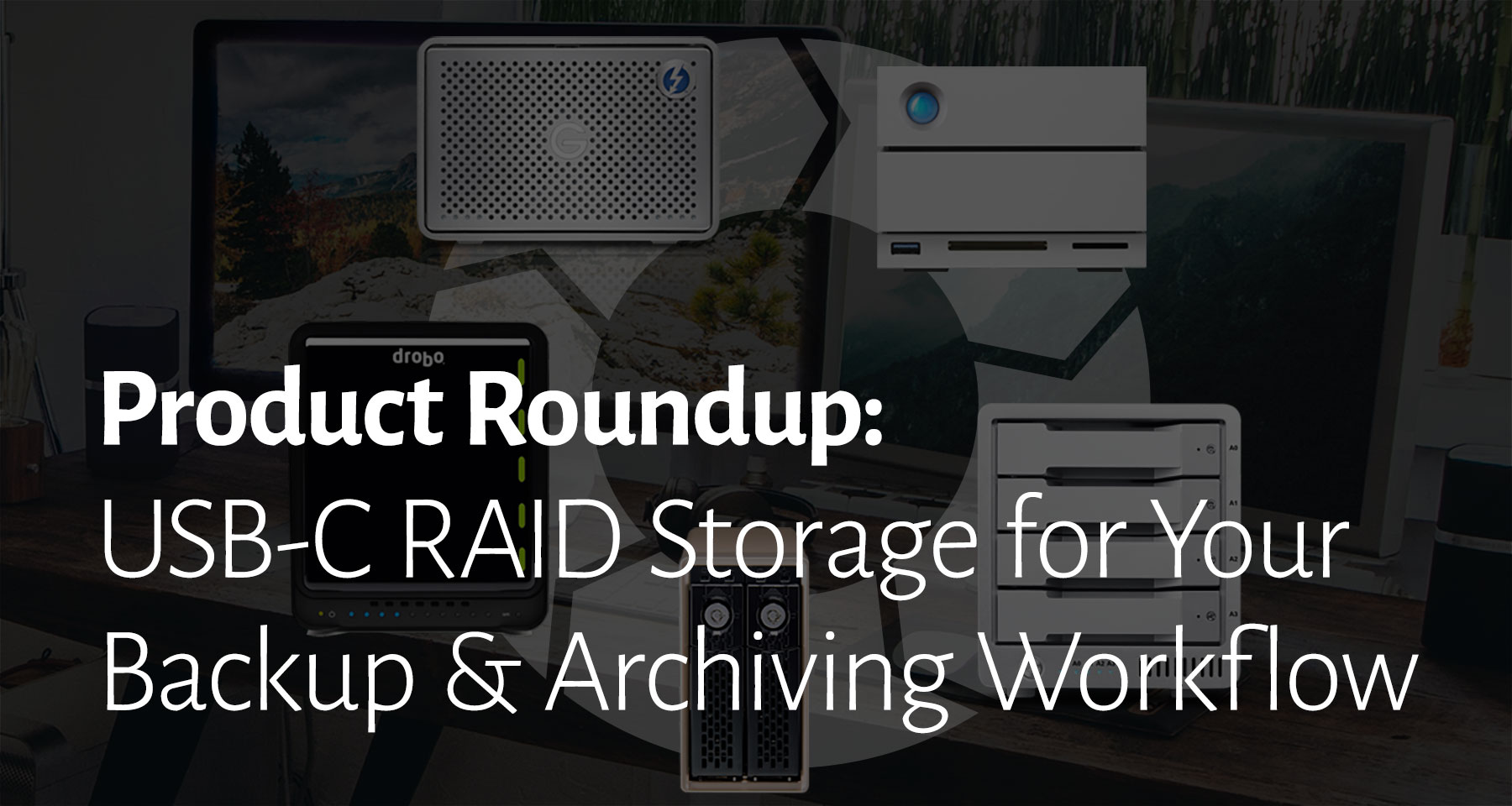
At ProStorage, we love RAID. Especially RAID 1 (especially USB-C RAID).
It’s not a secret. We’ve written about it here and here. If you’ve enrolled in our free How to Archive mini-course, you’ll know we highly recommend RAID drives in your backup and archiving workflow (if not, get on it, it’s free). If you are not familiar with RAID, go ahead and read the articles linked above, we’ll still be here when you are done. We’ll hold your spot.
Now that we’re all familiar with the joys of RAID, we thought we would do a product round-up to compare some of the RAID drives available. Since we are primarily concerned with backup and archiving, we will focus on RAID 1 applications. To this end, we tried to limit the drive bays to four in this product roundup.
We have also selected USB-C RAID drives. As we’ve previously reported, USB-C can mean a variety of different connection speeds. Most of the drives are Thunderbolt 3 which give the fastest speed, clocking in at 40 Gbps.
In no particular order, here’s what we’ve found:
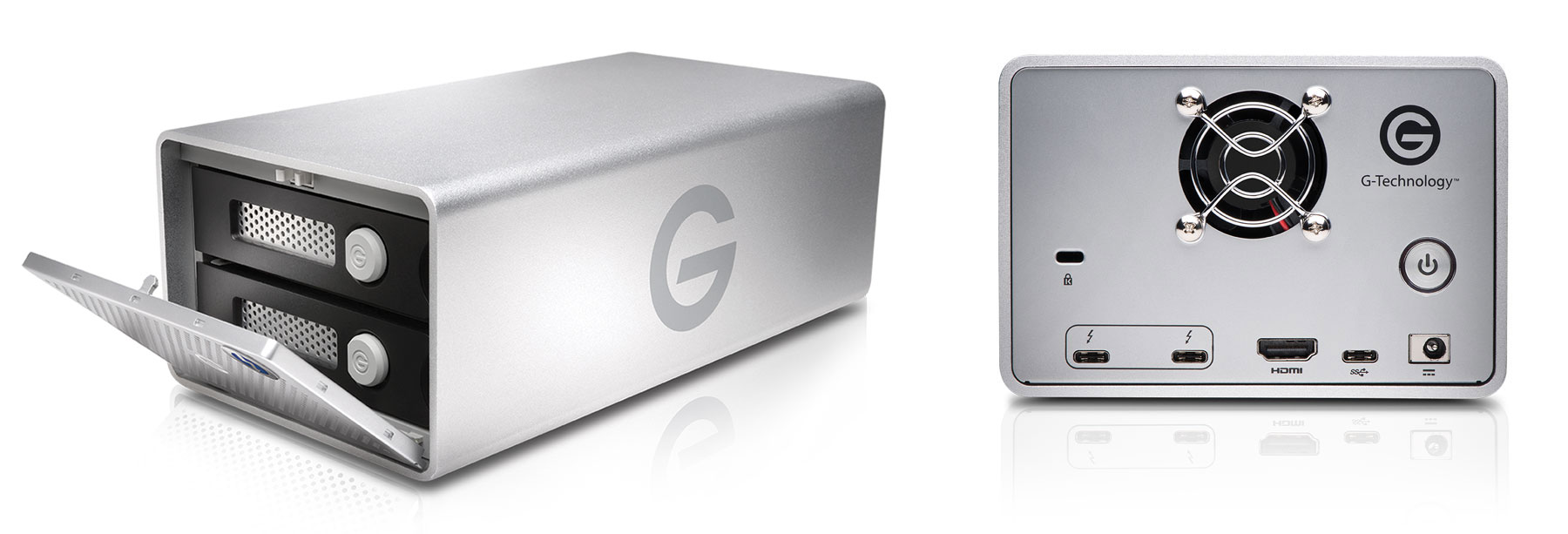
G-Technology G-RAID with Thunderbolt 3
The G-Technology G-RAID is a dual drive enclosure loaded with enterprise-level 7200 rpm hard drives. The G-RAID is hardware RAID so the RAID processing is handled by the drive. The drives are easily swappable by simply ejecting the drive, removing the drive sled on the old drive, and installing it on the new one with four screws.
As the name indicates, it features super-fast Thunderbolt 3 connection with an extra port so you can daisy-chain additional devices. It also contains a USB-C port for USB 3.1 Gen 1 (5 Gbps) for backwards compatibility. The final connection is an HDMI port, especially useful for video editors connecting a 4k monitor.
The G-RAID is available in capacities ranging from 8TB to 24TB (4TB to 12TB if using RAID 1) starting at $649.95 up to $1599.95. It is backed by G-Tech’s 5-year limited warranty.
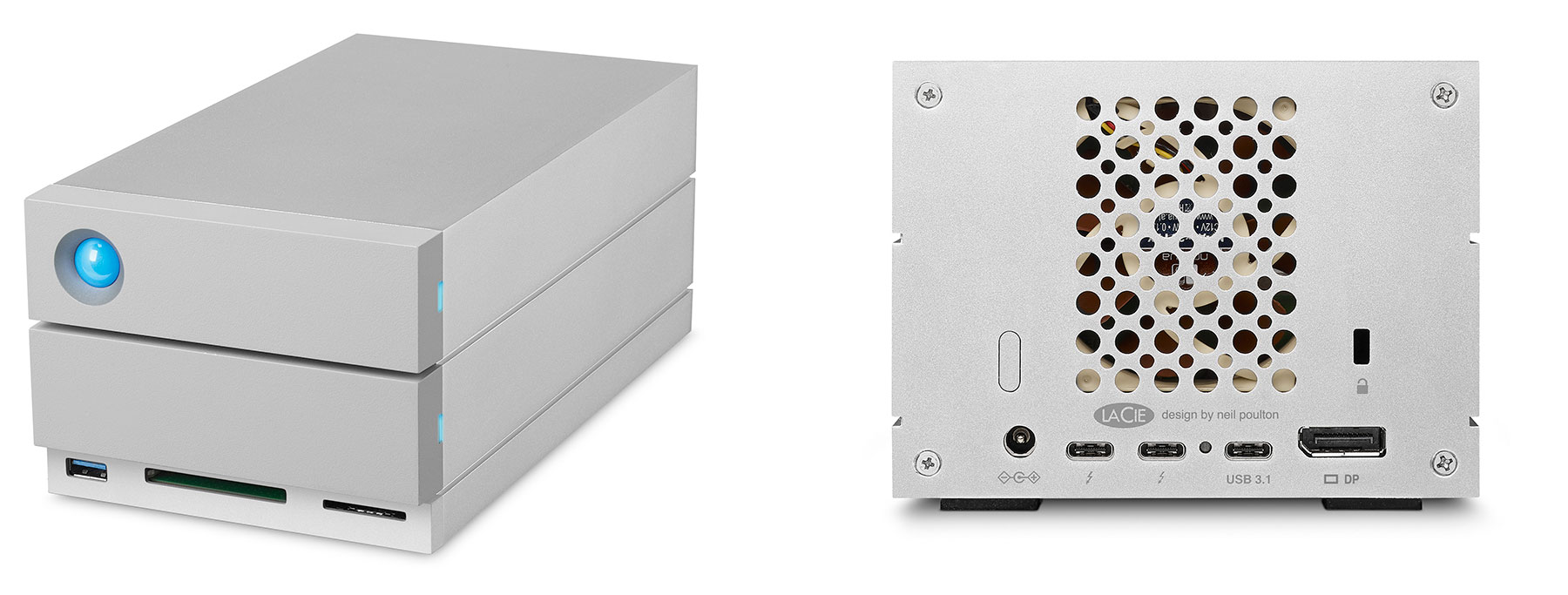
LaCie 2big Dock Thunderbolt 3
LaCie went all-in when they designed the 2big Dock Thunderbolt 3. Not only did they enlist long-time collaborator Neil Poulton for the industrial design, but they included a full compliment of ports and card slots for photographers and filmmakers–especially ones with newer Macs that only have USB-C ports.
Again, as the name suggests, in addition to providing hardware RAID on enterprise-level Seagate IronWolf Pro drives, the 2big Dock provides a plethora of connection options. In the front, there are CF and SD card slots and a USB 3 hub. The back has two Thunderbolt 3 ports for daisy-chaining any type of USB-C device, a USB 3.1 Gen 2 (10 Gbps) port, and a Display Port for a 4k monitor.
The 2big Dock is available in capacities ranging from 8TB to 20TB (4TB to 10TB if using RAID 1) starting at $699 up to $1299.
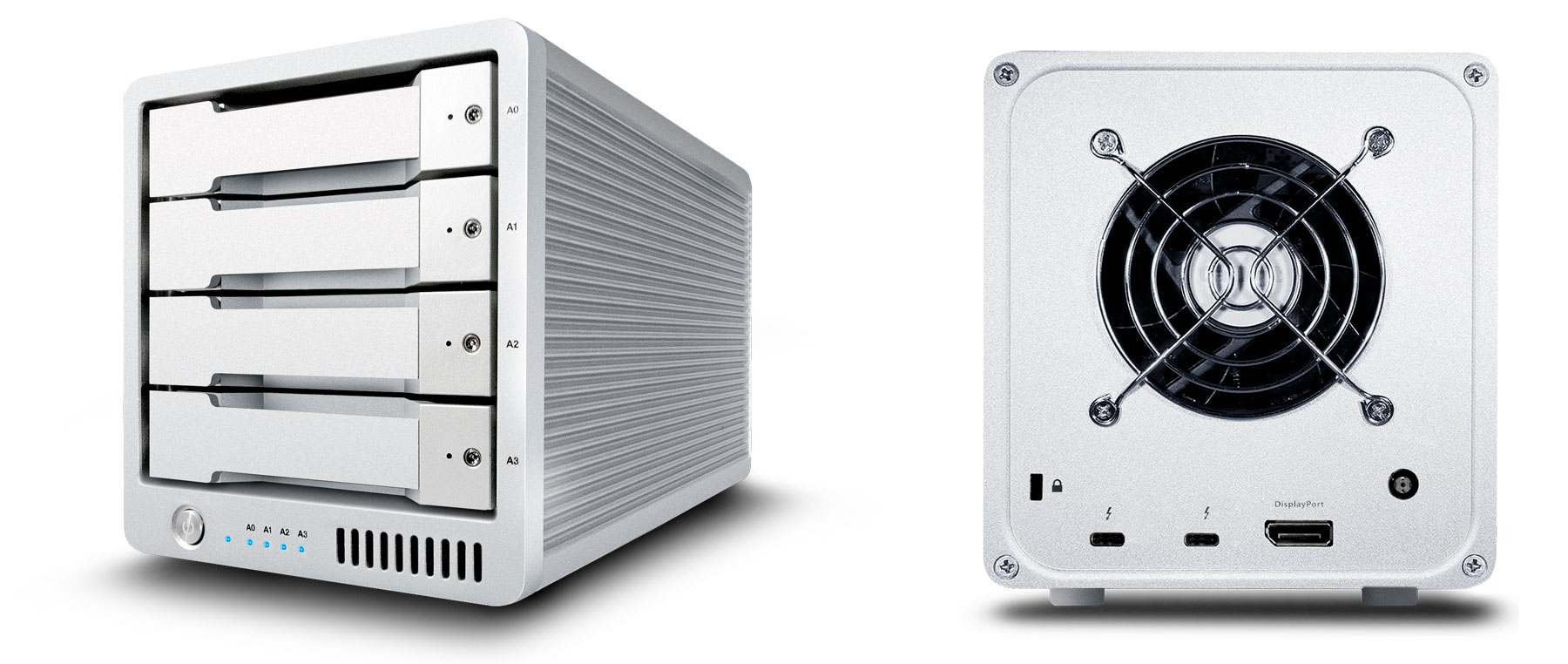
CalDigit T4
The CalDigit T4 RAID Thunderbolt 3 is a pretty sharp-looking 4-bay device which opens up possibilities for a different configuration. In addition to offering RAID 0 and 1, the T4 can also be configured as RAID 5, giving you a speed option while still maintaining a high level of protection.
While the biggest advantage of the T4 is the RAID 5 capability, it still boasts some handy features like hardware RAID, two Thunderbolt 3 ports for easy daisy-chaining of devices, and a Display Port for a 4k monitor. It is even possible to connect a 4k monitor via the Display Port and a 5k monitor using the extra Thunderbolt 3 port.
The T4 Thunderbolt 3 comes in capacities ranging from 8TB all the way up to 32TB with prices from $899 to $2299. There is also an insanely fast 8TB SSD version for a whopping $3499.
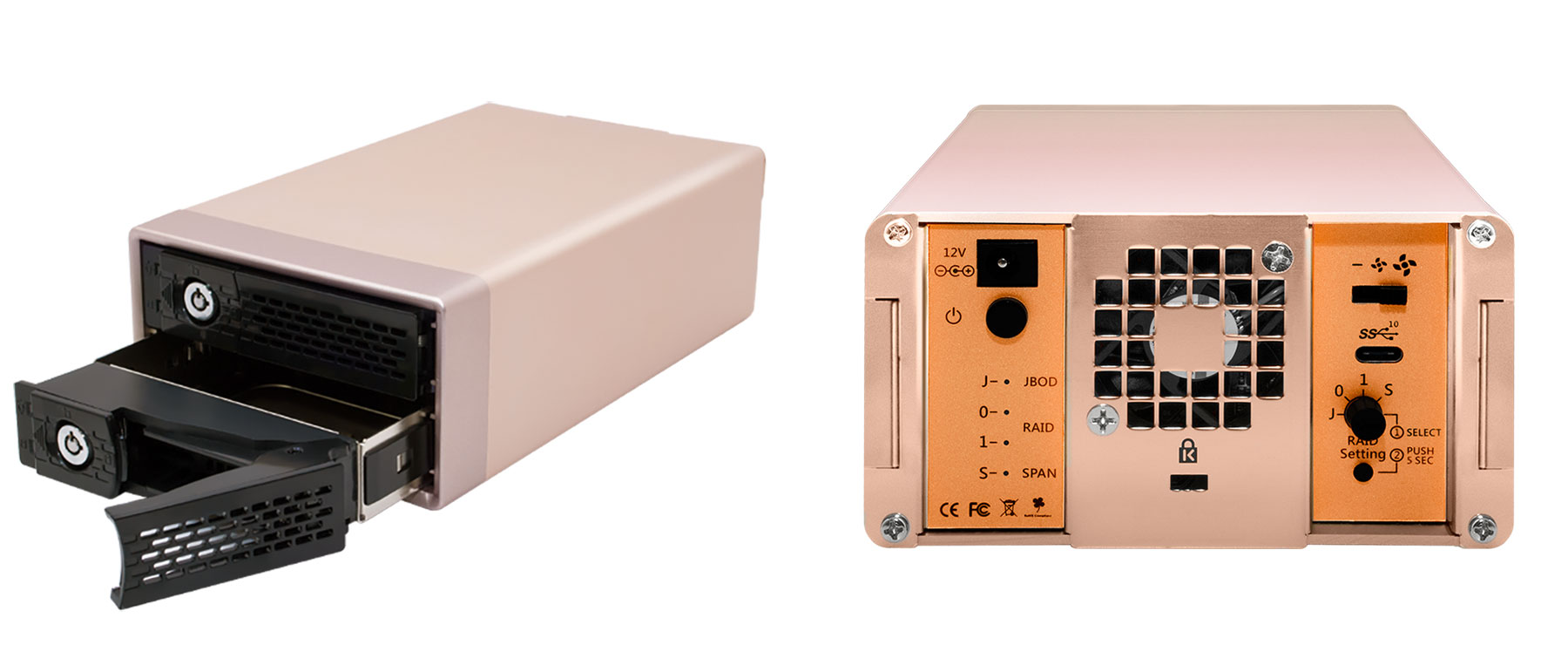
HighPoint NA460C USB-C RAID
The HighPoint NA460C Mini Dual-Bay enclosure is the most compact and potentially the most cost-effective RAID device in our roundup. It is sold as an enclosure only, so you can load it with whichever drives you prefer. The enclosure is USB 3.1 Gen 2, so the speed maxes out at 10Gbps vs the 40Gbps of Thunderbolt 3.
The NA460C is hardware RAID with a dial on the back for 4 different configurations: JBOD, RAID 0, RAID 1, and Span. JBOD stands for ‘Just a Bunch of Disks’ and allows you to use each disk separately. Span allows you do combine multiple drives into one, but it doesn’t break up files like RAID 0 so there is no speed benefit.
The back also has a speed control for the internal fan as well as a single USB-C port for connection. It is definitely not as full-featured as the previous RAID storage options, but at $362 (plus drives) it can get the job done in and archiving workflow.

Drobo 5D3
For some strange reason, we felt compelled to add the Drobo 5D3 in this roundup. Drobo is technically not RAID. They have a proprietary system they call BeyondRAID which, we suspect, is a variation of RAID 5.
The advantage to a Drobo system is you can mix & match drive brands and sizes with no apparent drawbacks. You also have the ability to swap out smaller drives for bigger ones to increase capacity on the fly. This flexibly comes with a price, however. Since BeyondRAID is proprietary, once you are committed to Drobo, it is very difficult to get out. If your enclosure fails, the only way to read your drives is in another Drobo enclosure.
The 5D3 has two Thunderbolt 3 ports as well as a USB-C port for legacy USB 3 devices. At $695 without drives, the Drobo 5D3 could potentially be the most expensive option in the roundup. While it is great for working backups, the Drobo system is not recommended for archiving purposes.
You don’t have to read a lot of How to Archive articles to notice that we are big fans of LaCie and G-Technology drives in general. But, there are plenty of other very good options out there that compare favorably on price and features.
Did we miss your favorite RAID storage? Let us know what you like in the comments below.
